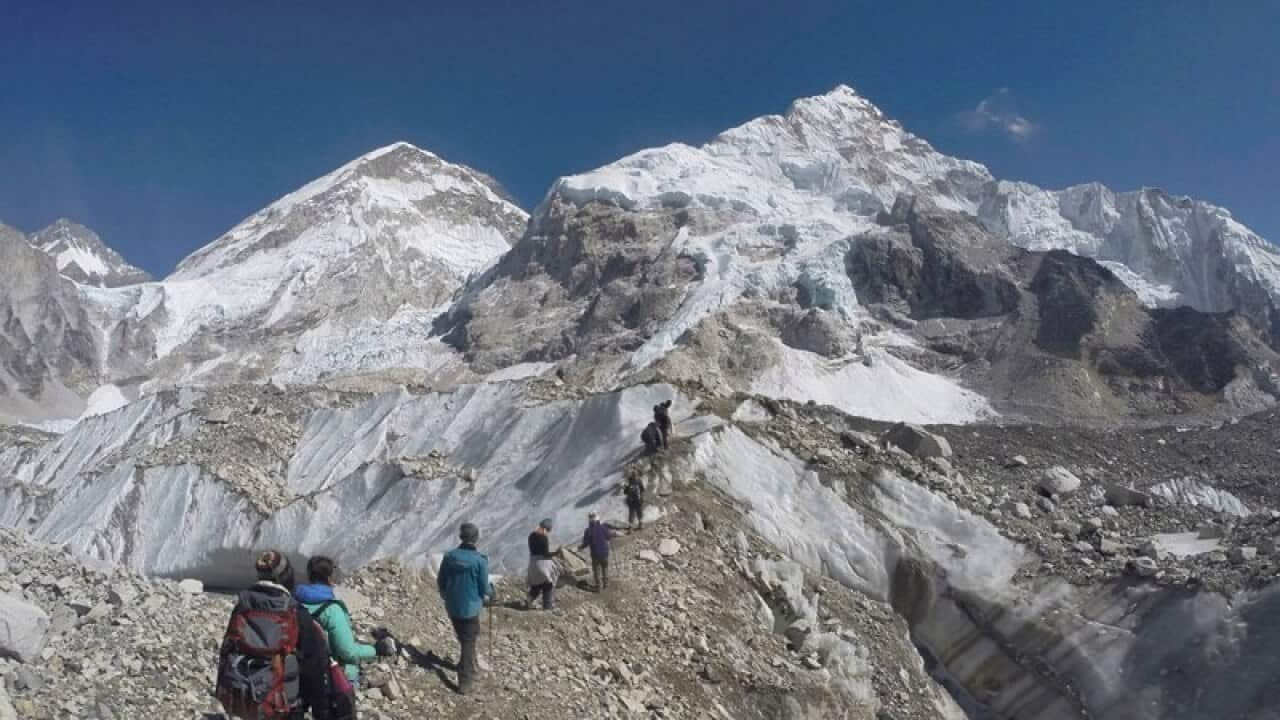The spring mountaineering season in Nepal has seen 18 people lose their lives across many mountains in the country.
Tourism officials say nine people have died on Mount Everest and the remaining nine died on four other mountains that are more than 8,000 meters in height.
It comes as authorities attempt to retrieve five other bodies from the Indian Himalayas, spotted in the search for eight mountaineers, including Australian woman Ruth McCance, who became lost while attempting to summit a previously unclimbed peak on Nanda Devi East.
'Overcrowding didn't cause deaths'
Mountaineers from India, Chile, Peru, Bulgaria, Malaysia and Nepal are also reported to have lost their lives on some of the world's tallest mountains in Nepal this season.
However, officials say the cause of those deaths include weakness, high altitude sickness and heart attack.
Meena Acharya, from the Department of Tourism, told SBS Nepali: ''In comparison to Everest we had issued a very small number of permits for Makalu and Kanchenjunga, but there too we had quite a few numbers of deaths. That is why overcrowding is not the only reason for the death of these mountaineers."
The government says it issued 32 permits for Kanchenjunga, 98 for Lhotse, 53 for Makalu and 23 for Annapurna for this spring season.

Nuptse and Lhotse summits. Solukhumbu. Nepal. (Photo by: Godong/UIG via Getty Images)
Everest death toll 'highest in four years'
The death toll on Mount Everest this season is currently sitting at nine, which, according to officials, is three more than the annual average.
Records from the Ministry of Culture, Tourism and Civil Aviation show mountaineers from Nepal, India, US and Europe are among the dead.
Criticism against the Nepali government for issuing too many climbing permits has continued.
This photo by mountaineer Nirmal Purja from Project Possible showing long queue of mountaineers on Everest also brought international attention to the issue.
In total 381 people had obtained a permit to scale Everest this season, but with the addition of local guides and support teams, more than 600 reached the top of the world’s tallest mountain.
However, some Nepali climbers have argued that Everest is not always so crowded.
Karma Tenzing, one of the climbers to summit Everest this year posted a picture on social media saying, ''I had the mountain to myself and spent an hour on top."
Officials say there are usually 12 climbing windows in a season, but this year there were just six and that, they say, caused congestion.
''This year's season started on May 14, and there were just two other windows which were just as brief,'' said Meera Acharya, director of the Department of Tourism.
On May 22nd, a new record was made, with more than 200 mountaineers climbing Everest on a single day.
Expedition organisers not wishing to identify themselves have argued that at least two climbers lost their lives due to loss of energy caused by the long queues on the mountain.
All of the climbers lost their lives while returning from the peak this season say, expedition teams.
However, Ms Acharya said that the government has received information that some of the deaths were related to climbers’ poor health conditions.
She blamed harsh weather conditions, insufficient training, health conditions of the climbers and inadequate oxygen as some of the other factors that cause death apart from climbing.
''We will have to think of some ways to avoid a similar situation where too many people are stuck at the same place, but the nine deaths that took place at Everest are not all related to this incident," Acharya said.
"None of the expedition teams told us that the deaths there were due to overcrowding. We have been informed of at least two freak accidents that happened after climbers unclipped their safety ropes."
Ms Acharya says most of the deaths were caused by altitude sickness, heart attack and weakness.
''There people are pushing themselves, who are not even capable of doing it try to summit and they instead of summitting they kill themselves," Rizza Alee, an Indian climber told local media. In the wake of global criticism, the government has said that it will think of ways to minimise the risk to climbers.
In the wake of global criticism, the government has said that it will think of ways to minimise the risk to climbers.

Indian mountaineer Rizza Alee has said overcrowding was an issue in Mount Everest. Source: Rizza Alee Facebook page
Secretary for Culture, Tourism and Civil Aviation Mohan Krishna Sapkota said that the government was mulling ways to ensure the fitness of the climbers.
''We have to ensure that climbers are hundred per cent fit to climb Everest, for that we are planning to conduct a medical checkup of the climbers at the base camp," he said.
“The other plan is to make it compulsory for climbers to take an advanced climbing course before joining Everest expedition team."
The government, however, has so far stayed silent about its plans to lower the number of permits.

